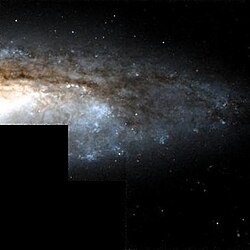| NGC 4527 | |
|---|---|
 SDSS image of the spiral galaxy NGC 4527. | |
| Observation data (J2000 epoch) | |
| Constellation | Virgo |
| Right ascension | 12h 34m 08.466s [1] |
| Declination | +02° 39′ 14.414″ [1] |
| Redshift | 0.005791 [1] |
| Heliocentric radial velocity | 1736 ± 1 km/s [1] |
| Distance | 48.9 Mly |
| Apparent magnitude (V) | 11.4 [1] |
| Characteristics | |
| Type | SAB(s)bc [1] |
| Size | ~104,100 ly (31.92 kpc) (estimated) [1] |
| Apparent size (V) | 6.2′ × 2.1′ [1] |
| Other designations | |
| IRAS 12315+0255, UGC 7721, MCG +01-32-101, PGC 41789, CGCG 042-156 [1] | |
NGC 4527 is a spiral galaxy in the constellation Virgo. It was discovered by German-British astronomer William Herschel on 23 February 1784. [2]
Contents
NGC 4527 is a member of the M61 Group of galaxies, which is a member of the Virgo II Groups, a series of galaxies and galaxy clusters strung out from the southern edge of the Virgo Supercluster. [3]
